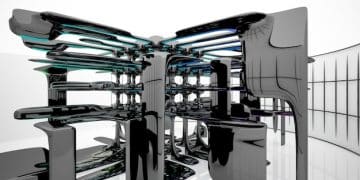Renewable Energy Revolution: Future Tech Driving US Goals

The renewable energy revolution, propelled by future technologies, is critical for the US to achieve its sustainability goals, driving innovation and reducing reliance on fossil fuels.
The renewable energy revolution: future tech driving US sustainability goals is no longer a distant dream but a rapidly approaching reality, fueled by groundbreaking innovations and a growing commitment to environmental responsibility.
The Dawn of Renewable Energy in the US
The United States is at a pivotal moment in its energy history. With increasing concerns about climate change and a desire for energy independence, renewable energy sources are taking center stage. Future technologies are not just supporting this transition; they are actively driving and accelerating it.
This section explores the current state of renewable energy in the US, highlighting key areas where technological advancements are making a significant impact.
Key Renewable Energy Sectors
Several sectors are leading the charge in the US renewable energy revolution. Each of these sectors benefits from unique technological advancements.
- Solar Power: Advancements in photovoltaic (PV) technology are increasing efficiency and reducing costs.
- Wind Energy: Taller turbines and offshore wind farms are capturing more energy than ever before.
- Hydropower: Modernization of existing dams and development of new, eco-friendly hydro projects are boosting production.
- Geothermal Energy: Enhanced geothermal systems (EGS) are tapping into previously inaccessible resources.

The integration of these renewable sources into the national grid is becoming more seamless thanks to smart grid technologies. These systems optimize energy distribution and ensure reliability.
Advanced Materials and Manufacturing
The renewable energy sector’s growth is heavily reliant on advanced materials and innovative manufacturing processes. These advancements are crucial for improving efficiency, durability, and cost-effectiveness.
This section delves into the specific materials and manufacturing techniques that are revolutionizing renewable energy technologies.
Materials Revolutionizing Renewable Energy
The development of new materials is critical for enhancing the performance of renewable energy systems.
- Perovskites: These materials are showing promise in increasing the efficiency of solar cells.
- Carbon Fiber: Used in wind turbine blades, carbon fiber reduces weight and increases blade length, leading to greater energy capture.
- Rare Earth Elements: While controversial, these elements are essential for high-strength magnets in wind turbines and electric vehicle motors.
Additive manufacturing, or 3D printing, is also playing a crucial role. It enables the creation of complex components with greater precision and reduced material waste, driving down manufacturing costs.
The Role of AI and Machine Learning
Artificial intelligence (AI) and machine learning (ML) are transforming the renewable energy landscape. These technologies are enabling more efficient energy production, distribution, and consumption.
Here, we explore how AI and ML are being applied across various aspects of the renewable energy sector.
AI and ML Applications in Renewable Energy
AI and ML are being used in several innovative ways to optimize renewable energy systems.
- Predictive Maintenance: AI algorithms analyze data from sensors on wind turbines and solar panels to predict maintenance needs, reducing downtime and costs.
- Grid Optimization: ML is used to balance supply and demand on the grid, ensuring efficient distribution of renewable energy.
- Energy Forecasting: AI models predict energy production from solar and wind sources, helping grid operators plan accordingly.
Furthermore, AI-powered energy management systems are helping consumers optimize their energy usage, reducing waste and lowering bills.

Energy Storage Solutions
One of the biggest challenges in renewable energy is intermittency. The sun doesn’t always shine, and the wind doesn’t always blow. Energy storage solutions are essential for ensuring a reliable supply of renewable energy.
This section examines the latest advancements in energy storage technologies, including batteries, pumped hydro, and thermal storage.
Types of Energy Storage Technologies
Various energy storage technologies are being developed and deployed to address the intermittency of renewable energy.
- Lithium-Ion Batteries: These are the most common type of battery storage, used in everything from electric vehicles to grid-scale storage.
- Pumped Hydro Storage: Water is pumped uphill to a reservoir and released when energy is needed, turning turbines to generate electricity.
- Thermal Energy Storage: Heat or cold is stored for later use, often in the form of molten salt or ice.
Additionally, hydrogen energy storage is gaining traction. Hydrogen can be produced from renewable energy and stored for later use in fuel cells or combustion engines.
Smart Grids and Microgrids
The integration of renewable energy into the existing grid requires smart grid technologies. These advanced systems enable real-time monitoring, automated control, and two-way communication between energy providers and consumers.
Microgrids, smaller localized grids that can operate independently, are also playing a critical role in enhancing the resilience and reliability of renewable energy systems.
Benefits of Smart Grids and Microgrids
Smart grids and microgrids offer numerous benefits for the integration of renewable energy.
- Enhanced Reliability: Smart grids can automatically reroute power to avoid outages and quickly restore service after disruptions.
- Improved Efficiency: Real-time monitoring and control optimize energy distribution, reducing waste.
- Increased Flexibility: Microgrids can operate independently during grid outages, ensuring a continuous supply of power to critical facilities.
Furthermore, smart grids and microgrids facilitate the integration of distributed renewable energy sources, such as rooftop solar panels, into the grid.
Policy and Investment Drivers
Government policies and private investments are crucial for accelerating the renewable energy revolution. Supportive policies create a stable market environment, incentivizing investment and innovation.
This section highlights key policies and investment trends that are driving the growth of renewable energy in the US.
Key Policy and Investment Trends
Several policies and investment trends are shaping the renewable energy landscape in the US.
- Tax Credits: Federal and state tax credits for renewable energy projects and equipment reduce the upfront costs, making these technologies more competitive.
- Renewable Portfolio Standards (RPS): These mandates require utilities to generate a certain percentage of their electricity from renewable sources.
- Public Funding: Government-funded research and development programs support innovation in renewable energy technologies.
Private investment in renewable energy is also on the rise, driven by growing investor interest in sustainable and socially responsible investments.
| Key Point | Brief Description |
|---|---|
| ☀️ Solar Power | Advancements in PV tech are boosting efficiency and cutting costs. |
| 💨 Wind Energy | Taller turbines and offshore farms capture more energy. |
| 🔋 Energy Storage | Essential for reliability due to the intermittency of renewables. |
| 🤖 AI and ML | Optimizes energy production, distribution, and consumption. |
Frequently Asked Questions
▼
The primary sources of renewable energy in the US include solar power, wind energy, hydropower, geothermal energy, and biomass. Each source contributes uniquely to the nation’s renewable energy mix.
▼
AI and machine learning optimize energy production through predictive maintenance, balance grid supply and demand, and forecast energy production from variable sources like solar and wind, enhancing overall grid efficiency.
▼
Energy storage addresses the intermittency of renewable sources such as solar and wind by storing energy for use when these sources are unavailable, ensuring a reliable energy supply regardless of weather conditions.
▼
Smart grids enable the efficient integration of renewable energy by providing real-time monitoring, automated control, and two-way communication between energy providers and consumers, optimizing distribution and reducing waste.
▼
Policies driving renewable energy growth in the US include tax credits for renewable projects, Renewable Portfolio Standards (RPS) mandating renewable energy use, and public funding for research and development.
Conclusion
The fusion of future technologies with renewable energy is paving the way for a sustainable and resilient energy future in the United States. By embracing these advancements, the US can achieve its sustainability goals, reduce its carbon footprint, and secure a cleaner, more prosperous future for generations to come.





